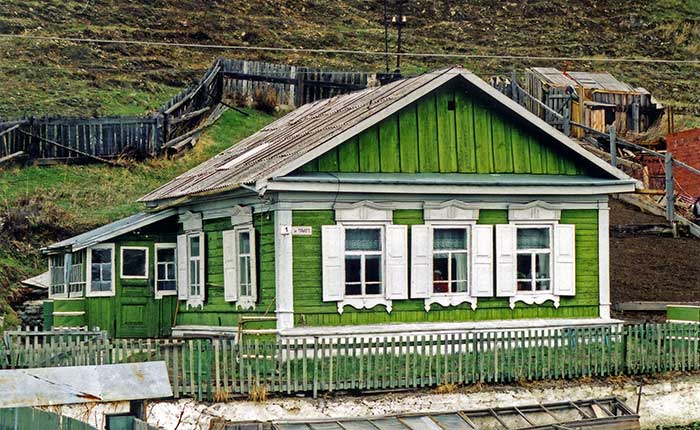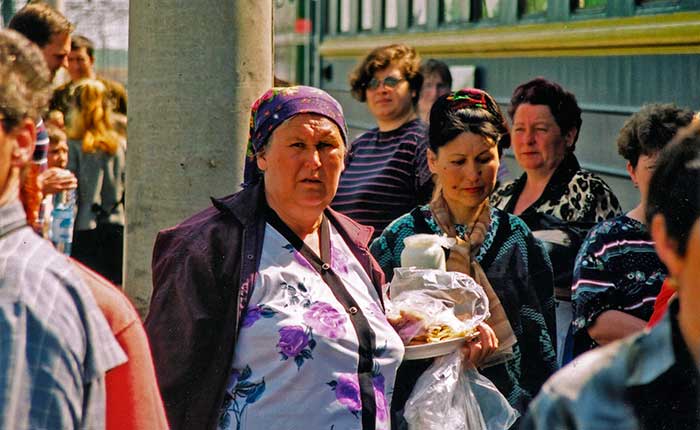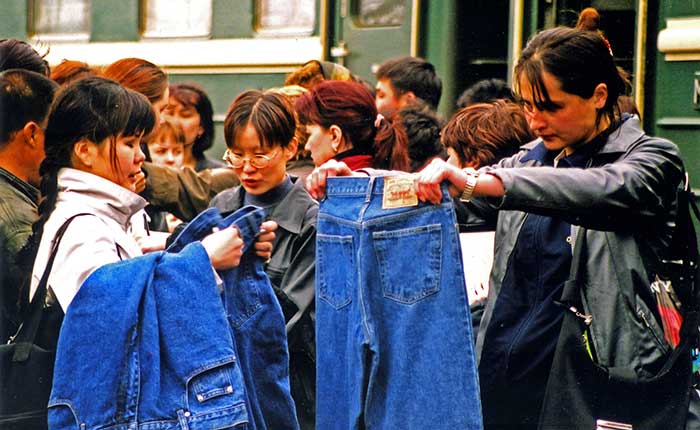By the time I got to Irkutsk, my hair felt like cold spaghetti.
Four days and 3000 miles all the way by train from Moscow. And no showers. The Trans-Siberian continues to Vladivostok another 3000 miles further down the track, but I got off in search of soap and hot water.
Then, like most who ride the world's longest railway for pleasure, I made a huge fork right and south through Mongolia, across the Great Wall to China, and finally Beijing. I also had the longest, deepest bath in history.
 The huge train only stops for a few minutes at this pretty out of the way station
The huge train only stops for a few minutes at this pretty out of the way stationTsar Alexander III fully understood the importance of uniting the huge Russian continent when he ordered work on the Trans-Siberian to commence in 1891. The new railway would open up vast tracts of mineral-rich land beyond the Urals, provide a convenient way to ship convicts off to Siberia and enable the swift movement of troops to the Amur region which was under increasing threat from the Chinese.
The first commission he set up to assess the line's construction declared it would bankrupt the country, so he simply disbanded it and formed a new one, which conveniently reached a more positive conclusion.
The Trans-Siberian is no tourist train. It's usually booked solid and provides a vital service for Russians, Mongolians and Chinese who can't afford the plane or need to transport large quantities of luggage. One hundred years ago, when the first through trains started running all the way to Vladivostok, the brochures depicted marble baths, gymnasiums and even a darkroom for developing photographs. The reality was different: breakdowns, no restaurant cars and frequent broken rails.
Today the conditions are somewhat better. I shared a four-berth compartment in second class, which was comfortable, if a little cramped. Toilet facilities are not dissimilar to what you'd find on a train in the UK - but if you're thinking of washing, forget it.
I'd had nightmares of babushkas with bags of smelly food and drunk soldiers, but two of my compartment companions turned out to be English. At first I was disappointed - no mad mime language, no scary experiences - but Duncan and Christine were great company and we became firm friends during our four days on board. The first night we sat on the two upper bunks and chatted late as the train swayed and clattered along, a bottle of vodka encouraging friendship. Olga and her little boy Sasha slept soundly on another bunk below.
 They may look a little ram-shackle, but Siberian houses are warm and cosy inside
They may look a little ram-shackle, but Siberian houses are warm and cosy insideThere's definitely something about sleeping on a train - or maybe it was the vodka? I woke late to find a brilliantly sunny day. The train was rattling along. Over the next few days its rhythm became a kind of second heartbeat.
Outside, big industrial smokescapes had given way to green rolling hills dotted with wooden huts, each with a wisp of smoke curling up from the chimney and a garden of carefully spaced vegetables.
Little old ladies in headscarves staggered along muddy tracks with heavy bags, old men and kids peered out of windows as we growled by, a noisy personification of the old power of Moscow.
Every couple of hours the rattle and sway was broken by a station stop. On the platform, food was hawked by all and sundry: khaki-coloured smoked fish the size of your thigh, little plastic bags of blini - Russian pancakes which tasted surprisingly good - fruit, vegetables and biscuits. Kiosks on the platform sold drinks and sweets and cigarettes. For ten or 15 minutes we bumped up against life in the middle of nowhere in Siberia, and then, in an instant, left it behind again.
 Selling produce to passengers on the train is a vital source of income for many locals
Selling produce to passengers on the train is a vital source of income for many localsThe time passed strangely quickly. Corridor friendships were struck up swiftly and the routine of the train took over. Everything takes longer in the cramped compartment: getting up, eating some picnic lunch, finding a book – a whole sequence of 'Could I just put my foot here so I can get my bag?'; 'Could I borrow your bottle opener?' You can't help but get to know your companions. Intimacy is thrust upon you. And it works just fine. Four days is enough to find plenty to talk about without discovering the quirky habits that start to grate over a longer period of time.
 There is a menu, but usually you just take whatever they're serving and hope for the best
There is a menu, but usually you just take whatever they're serving and hope for the bestIn the evenings we dined in the restaurant car. At the Paris Great Exhibition in 1900, the Russian government put on a lavish display featuring a full mock-up of the Trans-Siberian's restaurant car with mahogany-panels and extravagant menus. Each night our grumpy waitress with the bad bleach and perm-job, would drop the menu on the greasy tabletop. Inside its bashed cover dishes were listed in Russian, English and German.
On the first night we tried to order some and realised the choice was far more limited. It was any of the four things that had a price scrawled beside them. After this we adopted the Russian technique of ordering beers, feigning disinterest and trying to catch her by surprise by suddenly asking what food there was.
Irkutsk finally arrived at 3am Moscow time on the fourth day. Except my watch said that it was 8. Since leaving the Russian capital we had crossed five time zones. This time warp is more subtle than jet lag and quite disorientating - and just to make things really confusing, the train and stations all across Russia run to Moscow time.
Read more > A tale of vodka and darkness
Irkutsk is rather generously referred to as the 'Paris of the East'. In the rain and wind, the grubby streets and grey buildings felt like dour old Russia, but after the longest bath in the world, I strolled along the river bank, the sun came out and I had to think again. Particularly when Julia, one of the most striking women I've ever bumped into, asked me for directions. She was from Ulan Ude further towards Mongolia. Her eyes were intense, her cheekbones magnificent. She looked at me like I was from Mars when I confessed I was English. "Wow!" she said. If only I could make such a devastating impression at home. Maybe it was the aroma of soap and shampoo?
 The station platform at Ulan Ude turns into a huge market the moment the train pulls in
The station platform at Ulan Ude turns into a huge market the moment the train pulls inI boarded the train again next day, bound overnight for Ulan Bator, the capital of Mongolia.
We passed some of the trip's most impressive scenery soon after Irkutsk. Lake Baikal, the world's largest freshwater lake, home to hundreds of unique species including freshwater seals, was dazzling. Huge blocks of ice on its surface made the sunlight bounce crazily back and forth.
Most of the railway was constructed by gangs of convicts with nothing more than picks and shovels and this was some of the most difficult terrain, requiring over 200 trestles and bridges, and 30 tunnels. Prior to 1904, trains had to be loaded onto boats to cross the lake. The trip was particularly unpredictable in winter when thick ice often marooned the ships in port for weeks at a time.
This train was packed with Mongolian traders, the compartments bulging with boxes. Fish paste, mechanical valves, moisturising lotion, booze and fags and all manner of clothes spilled out into the corridors. To avoid customs, traders stash stuff in every conceivable hiding place: behind bulkheads, in underfloor compartments and behind ceiling panels. Boxes of clothes were broken down into smaller packages to fit into hiding holes. In the corridor people painstakingly threaded electrical wire down the length of the carpet.
Ulan Bator was a fascinating concoction of ex-Communist drabness and Asian dynamism. Brand new Toyotas jostled for space on the roads with bashed up old Russian Volgas and Ladas. Stalinist architecture stood crumbling in faded grandeur alongside shiny new office blocks.
On my one night there, I visited the state theatre to hear Mongolian throat singing. A little rotund man creased his brow like he was slightly constipated, opened his mouth and emitted a strange buzzing noise from deep in his chest. The tone rose to a high-pitched gurgle that oscillated and vibrated. It sounded like he'd swallowed a Jew's harp.
 Cabin attendants on the Chinese train tended to be a little friendlier than their Russian counterparts.
Cabin attendants on the Chinese train tended to be a little friendlier than their Russian counterparts.The next day, it was a hot ride through the Gobi desert to the Chinese border. The greenness of the steppe slowly became brown then yellow as we hit the vast desert. Herds of gazelle bucked and bounced, dashing away as the train rumbled past. A night of interrupted sleep followed as we crossed another border.
To make the process more laborious, the track gauge in China is different. In one of the most technically complex manoeuvres I've seen, the whole train was shunted into a huge shed, the coaches uncoupled and massive hydraulic lifting bars inserted under them. In unison they were all lifted several metres clear of the bogies which were then pushed out from underneath. New, narrower-gauge bogies were rolled in and the carriages slowly winched back down. For the three hours this took place, we had to stay on board and the toilets were locked.
We ploughed on through China. Beside the tracks people toiled in conical straw hats in the sun, irrigating and planting. Early afternoon, the train began the long wheezing climb up the mountain range that's crested by the Great Wall. There's time at the top to admire the views, as another loco has to be attached to help brake the train down the steep descent. The time seemed to speed up as we clattered on across the plains to Beijing. We talked non-stop, realising that after living in each others' pockets for nearly a week, we'd soon be going our separate ways.
 The four person berths are basic and quite cramped, but often very sociable
The four person berths are basic and quite cramped, but often very sociableAnd finally, suddenly, we were there. We struggled to re-pack rucksacks, swapping books, exchanging email addresses and dumping the junk we'd accumulated.
I left the compartment last, taking a final look around. Now the train had come to a halt, the stillness of final standstill was strange. After thousands of miles and six time zones, my body was tuned to the constant swaying of the train.
For days after I got off, I still felt the rhythm of the rails under my feet. I also spent a lot of time in the bath.
Fancy a ride on the Trans-Siberian?
Get There: Fly direct from London to Moscow and return from Beijing with KLM.
Take the train: Most tourists take the Trans-Siberian from May to November. (It gets extremely cold in winter). There are several different routes you can take and organising tickets and visas is quite complicated. It's easiest to get a travel agent to handle the red-tape for you.
Do The Tour: Trans-Siberian experts Global Village offer a range of great trips from Moscow to Beijing with the Russia Experience. The trips include stops in Siberia and Mongolia and most accommodation and evening meals when you're not on the train.
Find Out More: Bryn Thomas' Trans-Siberian Handbook published by Trailblazer Guides is utterly indispensable. Highly recommended.